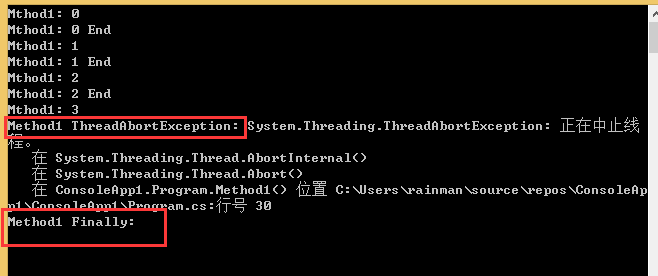1、Abort当前线程,后续程序不会执行
class Program
{
public static Thread thread1;
static void Main(string[] args)
{
thread1 = new Thread(Method1);
thread1.Start();
Console.ReadKey();
}
public static void Method1()
{
try
{
for (int i = 0; i < 10; i++)
{
Console.WriteLine("Mthod1: " + i.ToString());
Thread.Sleep(1000);
if (i == 3)
{
Thread.CurrentThread.Abort(); // 抛出的ThreadAbortException异常
}
Console.WriteLine("Mthod1: " + i.ToString() + " End");
}
}
catch (SocketException ex)
{
Console.WriteLine("Method1 SocketException: " + ex.ToString());
}
catch (ThreadAbortException ex)
{
// ThreadAbortException要在Exception的前面,因为Exception能够匹配所有异常
Console.WriteLine("Method1 ThreadAbortException: " + ex.ToString());
}
catch (Exception ex)
{
Console.WriteLine("Method1 Exception: " + ex.ToString());
}
finally
{
Console.WriteLine("Method1 Finally:");
}
}
}执行结果:
1、thread1.Abort()执行后会直接抛出ThreadAbortException异常。
2、异常会停止后续所有程序的执行(没有输出"Method1: 3 End")。
3、catch语句会执行。catch (Exception ex)和catch (ThreadAbortException ex)都可以捕获异常,由于Exception可以匹配所有异常,因此catch (ThreadAbortException ex)应该在catch (Exception ex)的前面使用,所以输出了“"Method1 ThreadAbortException”。
4、finally语句会执行。
2、Abort当前线程,进行try catch捕获异常
class Program
{
public static Thread thread1;
static void Main(string[] args)
{
thread1 = new Thread(Method1);
thread1.Start();
Console.ReadKey();
}
public static void StopMethod1()
{
try
{
thread1.Abort(); // 首先捕获抛出的ThreadAbortException异常
}
catch (Exception ex)
{
Console.WriteLine("StopMethod1: " + ex.ToString());
}
}
public static void Method1()
{
try
{
for (int i = 0; i < 10; i++)
{
Console.WriteLine("Mthod1: " + i.ToString());
Thread.Sleep(1000);
if (i == 5) StopMethod1(); // 再次捕获抛出的ThreadAbortException异常
}
}
catch (Exception ex)
{
Console.WriteLine("Method1: " + ex.ToString());
}
}
}运行结果:
try catch{} 捕获两次抛出的ThreadAbortException。
2、Abort当前线程,不进行try catch捕获异常
class Program
{
public static Thread thread1;
static void Main(string[] args)
{
thread1 = new Thread(Method1);
thread1.Start();
Console.ReadKey();
}
public static void StopMethod1()
{
thread1.Abort();
}
public static void Method1()
{
for (int i = 0; i < 10; i++)
{
Console.WriteLine("Mthod1: " + i.ToString());
Thread.Sleep(1000);
if (i == 5) StopMethod1();
}
}
}运行结果:
1、虽然线程抛出了ThreadAbortException异常,由于线程中没有使用try catch的语句捕获异常,所以看上去线程很平静的退出了。
2、而且,由于是在线程中抛出的异常,所以主进程没有任何错误提示。
3、for循环只输出到5,Abort()后一般线程会直接停止。
3、在一个线程中Abort另一个线程
class Program
{
public static Thread thread1;
public static Thread thread2;
static void Main(string[] args)
{
thread1 = new Thread(Method1);
thread2 = new Thread(Method2);
thread1.Start();
thread2.Start();
Console.ReadKey();
}
public static void StopMethod1()
{
try
{
thread2.Abort();
}
catch (Exception ex)
{
Console.WriteLine("StopMethod1: " + ex.ToString());
}
}
public static void Method1()
{
try
{
for (int i = 0; i < 10; i++)
{
Console.WriteLine("Method1: " + i.ToString());
Thread.Sleep(1000);
if (i == 5) StopMethod1();
}
}
catch (Exception ex)
{
Console.WriteLine("Method3: " + ex.ToString());
}
}
public static void Method2()
{
try
{
for (int i = 0; i < 10; i++)
{
Console.WriteLine("Method2: " + i.ToString());
Thread.Sleep(1000);
}
}
catch (Exception ex)
{
Console.WriteLine("Method2: " + ex.ToString());
}
}
}运行结果:
1、可以看到只在thread2中捕获到了ThreadAbortException异常。
2、thread1完整的运行完毕了,并且没有ThreadAbortException异常抛出。
总结
1、theadX.Abort()方法会在线程X中抛出ThreadAbortException异常,线程X中所有正在执行的try catch都会捕获该异常。
2、theadX.Abort()有可能在Y线程中调用的,不会在Y线程中抛出ThreadAbortException异常。



